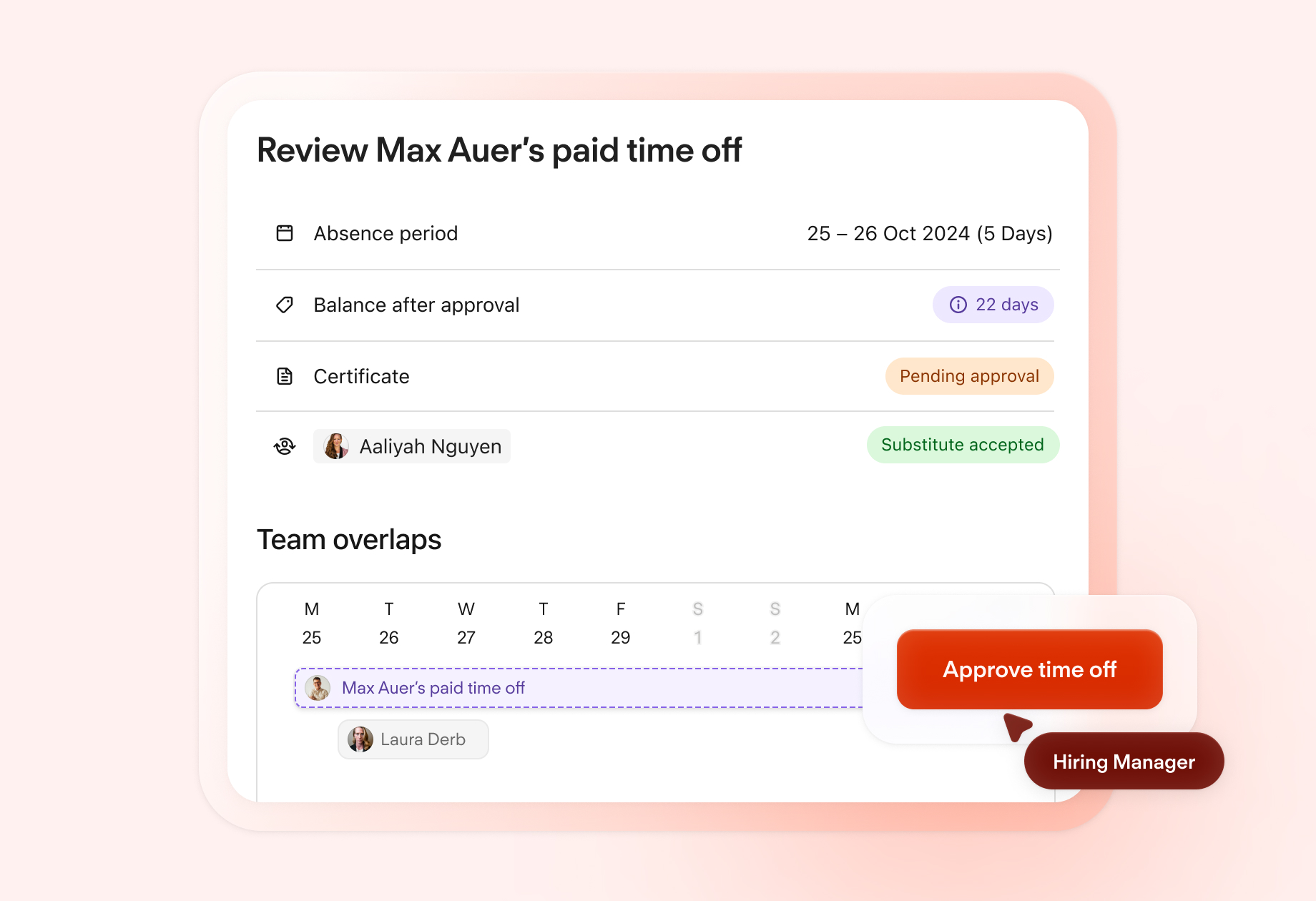Everything About Paternity Leave and Pay in the UK

Both maternity leave and paternity leave are regulated by law in the UK. Providing comprehensive support to new parents helps ensure they’re in the best position to remain productive employees. Learn more about paternity leave in the UK: eligibility criteria, how employees can apply and tips for supporting new fathers in the workplace.
Key Facts
Paternity leave is granted to employees who have a child with their partner through birth, adoption or surrogacy.
Employees must have worked with a company for at least 26 weeks before being eligible for paternity leave.
By law, companies continue to pay employees on parental leave and allow them to accrue holiday time.
Contents
- 1What Is Paternity Leave?
- 2Paternity Leave: Eligibility Criteria
- 3Shared Parental Leave and Pay
- 4How To Apply for Paternity Leave in the UK
- 5Holiday During Paternity Leave
- 66 Tips for Supporting Fathers in the Workplace
- 7Frequently Asked Questions About Paternity Leave and Pay in the UK
- 8Manage Paternity Leave Requests With Personio
What Is Paternity Leave?
UK law defines statutory paternity leave as two to three weeks of paid time off for employees with partners who are having a baby, conceiving a child via surrogate or adopting. Employment rights are fully protected during this leave of absence, allowing them to receive pay and return to work when ready.
Paternity Leave: Eligibility Criteria
To be eligible for paternity leave, the person must be legally classified as an employee under UK law. From there, the employee must be responsible for the child’s upbringing or their partner’s continued care. Generally, they must be the child’s father or the expectant mother’s partner (including same-sex couples).
A worker must have been consistently employed with the same company for 26 weeks. The prerequisites are similar in adoption or surrogacy as long as proper notice is given. In case of adoption, employees need to provide proof of adoption. In surrogacy, the parent must fill out a parental order for the law to recognise them as parents.
How the Law Protects Employees Taking Paternity Leave
The Equality Act of 2010 protects employees’ rights when they take a leave of absence by prohibiting discriminatory retaliation. That means an employer can’t mistreat someone returning from paternity leave or do things during their break that worsen their workplace situation. Some examples of mistreatment include reducing their hours, bullying or harassment and overlooking them for training opportunities.
Shared Parental Leave and Pay
If your company resides in England, Wales, Scotland or Northern Ireland, your workforce is potentially eligible for shared parental leave. If both parents meet statutory parental leave requirements, the mother can transfer all but the first two weeks of maternity leave to their partner.
It’s more complex to organise because the parents have more options on how they use their time off, but generally, they’re eligible for the following:
Up to 50 weeks leave and up to 37 weeks’ pay in the first year after their child is born
The ability to take their leave all in one go or three blocks with work in between
Continued pay during their leave of absence (£172.48 per week, or 90% of their average weekly earnings)
At a Glance: Easily Manage Absences Across Your Org

Make absence planning and tracking a pleasure, and not a pain, with Personio.
Track absences with PersonioHow To Apply for Paternity Leave in the UK
Employees must inform you at least 15 weeks before the baby’s due date to claim their statutory paternity leave and pay. If they’re adopting, they need to confirm they’re taking leave 28 days after they want it to start or within seven days after being matched with a child. They can do this by filling out a form.
Holiday During Paternity Leave
Your employees still accrue their holiday entitlement while on statutory paternity leave and any extra time off determined by company policy. They can’t use both simultaneously, but a company can agree to let them use their holiday allotment before or after their parental leave. Some employees might use their holiday time if they don’t meet all the paternity leave requirements.
6 Tips for Supporting Fathers in the Workplace
Employees are entitled to statutory paternity leave, but there are many other things a company can do to support new fathers within their workforce. While some businesses might say that normal paternity leave is enough, additional resources help ensure more positive outcomes for new families.
1. Talk With New Fathers
The first thing company leadership should do once fathers return from their leave of absence is speak to them and reset expectations. Considering their new at-home responsibilities, they might have unique employment needs within the workplace and different priorities in their work-life balance. Showing that you support them in this new chapter of their lives ensures the transition back to their jobs is as smooth as possible.
2. Tell Them Their Rights
Many new fathers aren’t aware of the rights they have under UK law. More than that, many employers don’t know those rights either, leaving no one to educate employees. Generally, the UK government gives new parents the right to request flexible accommodations from their employers. Knowing that and informing your staff demonstrates loyalty, which they will likely reciprocate in the long term.
3. Give Equal Resources to Both Parents
Support for new mothers is often more comprehensive than support for new fathers. While it’s not unimportant, your company shouldn’t disregard resources for non-birthing partners either. Society is adopting new stances on fatherhood, recognising that many are heavily involved in the day-to-day parenting of their children. Equalising your company’s support between all employees who are parents can help alleviate any stress affecting job performance.
4. Encourage Their Mental Health
Being a new parent is a stressful situation which a lack of consideration at work will only build upon. Old societal expectations for men often cause them to forgo seeking help because they’ve internalised a penchant for bottling up negative emotions. However, doing that tends to make those feelings express themselves negatively, potentially affecting their performance and demeanour at work.
Your company can support a father’s mental health during this new period of their life. You could do something as simple as asking how they’re coping with parenthood or pointing to mental health resources they can access. You can also recommend fatherhood support groups, books and other resources that may help them navigate this new stage of their life.
5. Set the Tone for Their Return
The new father’s team must be kept in the loop about their extended absence, so they can properly prepare for coverage. This helps ease the burden on the rest of the team, ensuring work gets done while the new father is enjoying time with their new child. But if the new parent missed out on some important milestones or deadlines, this could cause friction among the team. It’s important that managers communicate to their team why the new father is absent and to actively assist in their transition back to a regular working day to ensure best results.
Introducing Modern Holiday Planning & Management

Seamless absence tracking that scales with your headcount. See how Personio can help your team with absences today.
Book Your Demo6. Provide Flexible Support
Every father’s situation is different, and support that works for one employee might not work for another. New fathers will have individualistic needs like any other employee. Proper accommodation can help them maintain quality job performance. Flexibility often means adjusting worker schedules to fit the requirements of a new child or lightening their workload on their initial return to aid their mental well-being.
Frequently Asked Questions About Paternity Leave and Pay in the UK
How Long Is Paternity Leave for Fathers?
Paternity leave lasts for 1 to 2 weeks.
Do Employers Pay Paternity Leave?
Yes. Statutory Paternity Pay is either £172.48 a week or 90% of their average weekly earnings, whichever is lower.
How To Claim Paternity Leave and Pay
Employees must notify the employer about their extended absence at least 15 days before the baby is due. Once the notice is received, the company pays them through the usual channels at the rate set by UK law. This process differs if a new parent is adopting or welcoming a child via surrogate.
What Is Statutory Paternity Leave?
Statutory paternity leave is the amount of time determined by law that an employee is allotted to care for their new child or take care of the birthing parent.
Manage Paternity Leave Requests With Personio
Reconciling the law with your standard time off policy requires careful attention to ensure compliance and employee satisfaction. Mishandling statutory paternity leave can incur legal or financial penalties that can disadvantage your company significantly and sour your relationship with the employee. With Personio’s absence management tools, your employees can notify leadership of upcoming absences well in advance with only a few clicks.
At a glance, your HR office can see who’s absent for what reason and how much they’re being paid. Book a free demo and learn how else Personio can benefit your office!
Disclaimer
We would like to inform you that the contents of our website (including any legal contributions) are for non-binding informational purposes only and does not in any way constitute legal advice. The content of this information cannot and is not intended to replace individual and binding legal advice from e.g. a lawyer that addresses your specific situation. In this respect, all information provided is without guarantee of correctness, completeness and up-to-dateness.